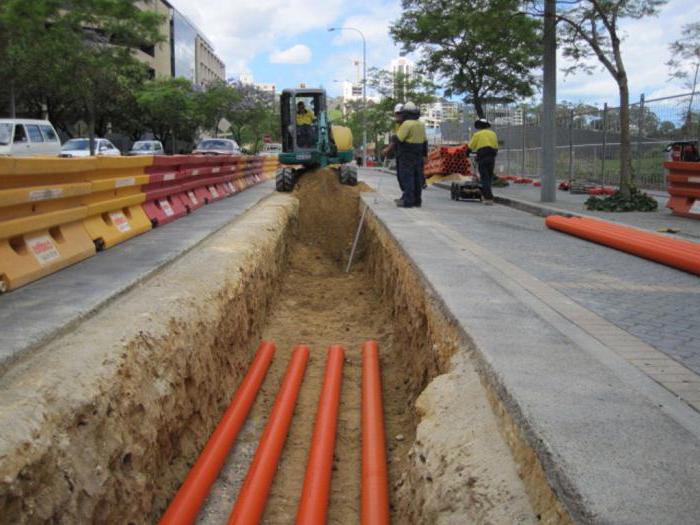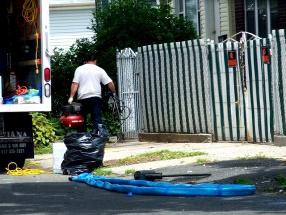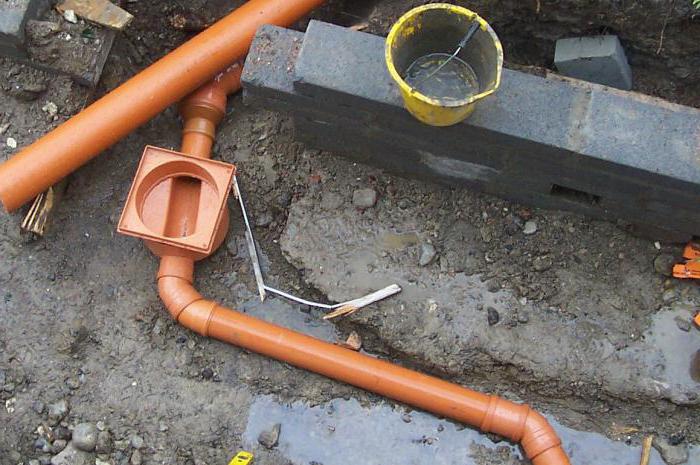Each of us at the mention of the expression"Sewage" before the eyes gets the system of collectors and pipelines, which move stormwater and household waste. However, this is not the only communications that can be laid underground. Another option for the underground sewer network is cable.

Description
The described system is an undergroundnetwork of capacities and channels, in which telephone and electric cables are laid. Such a system may include pipes as well as wells. The former are used for laying the wires, while the latter are needed for auditing, replacing, repairing and increasing power.
Cables can be laid openThis pipelines are not used, they are replaced by basements of buildings, tunnels and collectors. The lines in this case are strengthened with the help of special devices.

Purpose of cable ducts
Cable ducts are needed to protectwires from the weather and the load of the soil and pavement. It is used for the possible repair, replacement, and branching of telephone and electrical networks, while there is no need to open up the soil and destroy the roadway.
Varieties of cable sewer systems
The most common cable classificationThe sewer is one that is based on the method of laying pipelines. Installation of pipes is carried out in pre-excavated trenches. However, the laying may be trenchless, while the cable is above the ground, and the soil surface is not disturbed. Such installation is carried out according to the technology of horizontal drilling.

Similar systems may vary in size.the section and shape of the wells, the pipes themselves and the materials used in the manufacture of the elements. Wells can be plastic, brick and reinforced concrete. For such systems are used pipes from:
- asbestos;
- concrete;
- plastic;
- fiberglass;
- pitch fiber.
The most popular are plastic and asbestos. In some cases, plastic blocks are used instead of pipes, which have several sections called multichannels.
Cable ducting device
Cable sewage is arecessed channels that are at a depth, depending on the location of the material in the base of the pipe. Depth can vary from 40 to 200 cm. If we are talking about concrete pipes, then they can be laid even deeper, but plastic should be placed at the very least depth. The pipelines, which are under the tram tracks, are buried as deeply as possible, but the minimum - under the pedestrian zones. Under the roads, the elements are at an average depth.
Pipes have a slope of 4 mm per meter, thisallows you to provide a natural flow of water that can enter the channels. The cable and pipes between the wells should be located in a straight line, but a slight displacement is still allowed, it should not be more than 10 mm per meter of pipe. Inspection shafts are located every 25-150 m, the final value depends on the cable laying pattern. Inside large collectors and basements of buildings, cable is not laid in pipes, since the wires here are pulled along consoles.

Cable ducts may providethe presence of several tubes in the same trench, with the voltage wires should be the lowest in those that are located closer to the surface of the earth. The most suitable diameter is 100 mm, but previously used 15-cm pipe, which is more difficult to lay the cable. In one bundle should not be telephone and electrical cables.
Device manholes
Inspection wells for cable sewageMounted using the same technology as conventional drainage wells. They are containers with a bottom, the upper part of which is closed by a hatch, and a neck is installed between it and the well. In the side walls there are special holes for the exit and entrance of the pipe with cables. Most of these tanks have a double system of hatches, the internal of which has a secret lock, the key to it is only available to the owner of the well.
Depending on where the cable network is located, wells may be:
- checkpoints;
- stationary;
- separating.

The first variety is set to directsites or in those places where the deviation from a straight line does not exceed 30 °. As for the station and rotary wells, they should be located near the buildings or in the places of network bending, respectively. Dividing wells are located at the points of diversion or approach of several channels.
What else you need to know about manholes
The construction of cable ducts canprovide for the installation of wells of different sizes, they must be spacious so that they have the opportunity to work with the cable and install the equipment. Well capacities are made of different materials, but recently plastic products with stiffening ribs are more and more often used. This is especially true for conditions where the load is not so great. For example, well-built KKT-2 models can be found in the cable sewage system of the private sector; its diameter is 136 cm; equipment can be installed in it.
Work on cable sewage: the use of cable with copper conductors
Laying of cable ducts, which willto use a cable with copper conductors, requires the installation on the sealed end of the cable stocking of galvanic steel. For it will be fixed wire billet. Cable laying is carried out according to a certain technology; it provides for mounting the drum with a cable on devices such as jacks or carts.
These works are carried out by the hostwell The cable is fed in the upper part of the drum, and at the entrance to the channel should be plastic bushings or cable bends. In the suction well, the wire blank with cable begins to stretch, while at the feed sump the tension from the cable drum is constantly monitored. When the gasket in the span ends, the ends are checked for tightness and placed on the consoles. Cable laying in the cable duct in winter can be carried out at a temperature not lower than 10 ° С, whereas if a sheath of lead is used, the ambient temperature can be -20 ° С.

Features of double wall pipes
Double-walled conduit pipes havehigh ring stiffness, they are able to withstand impressive mechanical loads, which is especially true for corrugated products. Pipes have good flexibility, with the help of them you can bypass obstacles along the route.
You can operate them with a wide rangetemperatures, and the presence of special accessories allows you to create tracks of any complexity. Such pipes for cable ducts can have a length of from 35 to 150 m, they are supplied in coils and have a nylon broach. Even at low temperatures, they retain elasticity, and the minimum bend radius is equal to 8 diameters.
Conclusion
При необходимости монтировать колодец в Pedestrian area should take into account the design load on the tank, which is 10 tons. As for the roadway, this parameter increases to 80 tons.











